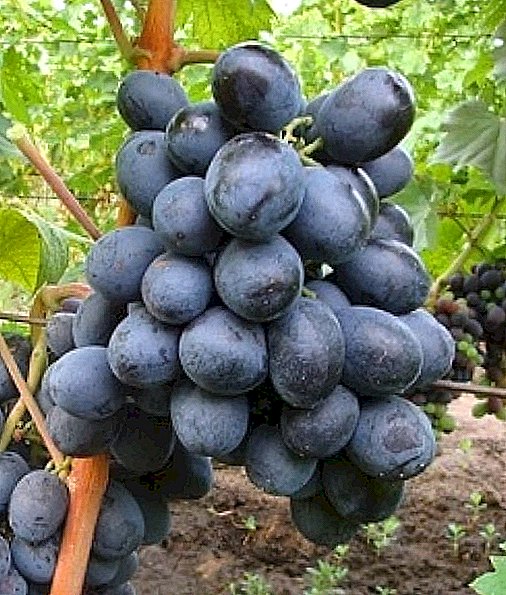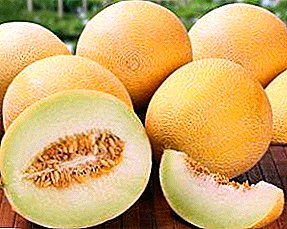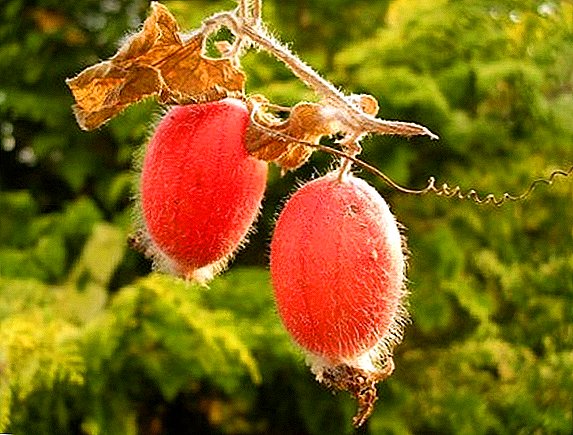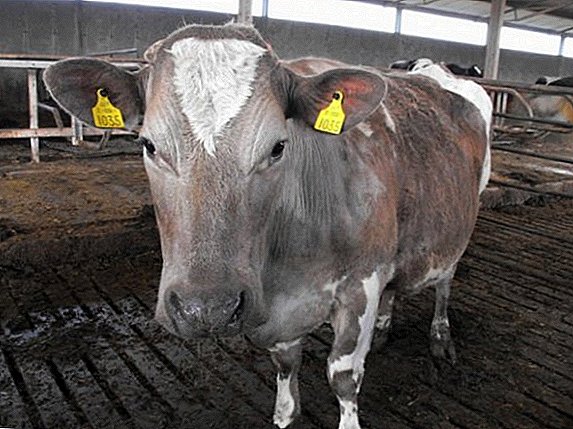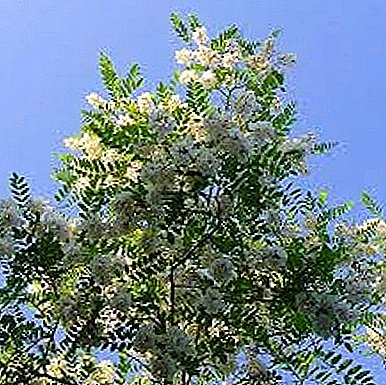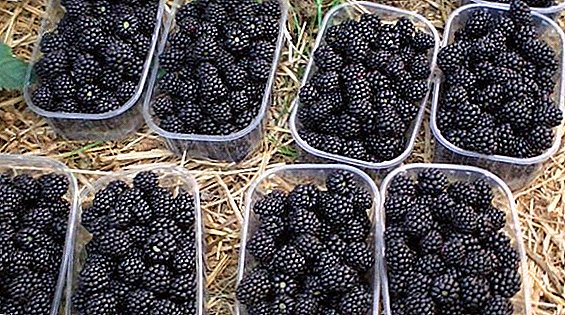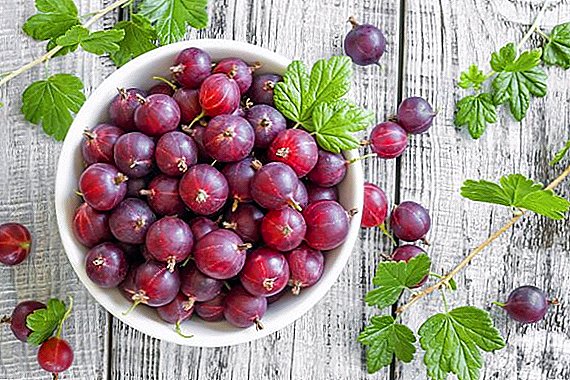 Gooseberry is a fruit plant widely grown in our state. With competent agrotechnics, the plant can consistently produce a rich harvest, due to which many gardeners have become fond of. There is a large number of cultivars, but the Consul variety, which is distinguished by the absence of thorns and high yields, is of particular value for gardeners.
Gooseberry is a fruit plant widely grown in our state. With competent agrotechnics, the plant can consistently produce a rich harvest, due to which many gardeners have become fond of. There is a large number of cultivars, but the Consul variety, which is distinguished by the absence of thorns and high yields, is of particular value for gardeners.
History of breeding varieties
"Consul" (another name "Senator") - a relatively new type of gooseberry. He was bred in 1995 by the employee of the South Ural Research Institute Ilyin V.S.
To obtain a new variety, such initial species as “African” and “Chelyabinsk Green” were used. From its second parent, "Senator" inherited frost resistance and resistance to atmospheric phenomena, thanks to which it is recommended for cultivation in the Urals, the Far East, and Siberia. 
Find out the distinctive features of the Grushenka gooseberry varieties, Commander, Kolobok, Malachite.
Description of the bush
The gooseberry bush belongs to the vigorous, its height reaches 180 cm. It has a medium sprout, thick crown and good spine formation. The branches of the "Consul" are of medium thickness, straight or slightly curved, with gray-brown bark, and reddish-brown shades at the base. The leaves differ in medium size, five-lobed form, bright green color with pronounced wrinkling.
The spikes of the plant are practically absent or in the middle part of the shoots in small quantities. Such features of the structure of the bush can save space on the site, greatly facilitate the care of him and the harvest.
Find out what can get sick and who can harm the gooseberry.
Description of berries
At the end of July gooseberries start ripening. They are round, medium size, weighing from 2.5 to 6.5 g, red or dark red. The peculiarity of the fruit of this variety is their thin skin and a small amount of seeds inside. The taste of "Consul" is a pleasant, moderately sour-sweet, with juicy transparent flesh.
On average, the yield of one bush is 3-6 kg. With proper care, the plant can live for over 20 years, with annual fruit. 
Did you know? As part of the gooseberry iron is much more than in apples, and in the amount of ascorbic acid it contains, it is second only to black currants.
Disease and pest resistance
"Senator" is not too demanding of growing conditions. It is resistant to various pests and infectious diseases, including powdery mildew. Not afraid of septoria and sawfly. Despite this, it is recommended to regularly inspect the hive for the presence of diseases or pests and, if necessary, to carry out minimal treatment with fungicides.
Drought resistance and winter hardiness
Another important advantage of the variety is its frost resistance. The bush withstands the early spring frosts, is not afraid of low temperatures to minus 30 degrees. Also, the plant is excellent against summer drought. For this reason, it is ideal for disembarking in regions where severe weather prevails.
Lighting Requirements
“Consul” is a culture unpretentious in the care and planting, but if you let the process of its development take its course, you should not hope for a high yield. First of all, for planting you need to choose a lighted place, because the gooseberry is a light-loving variety.  Windy areas and drafts should be avoided. It is preferable to plant a shrub along the fence, so that it is reliably protected from the wind. If we ignore such minimal recommendations, the plant will not be able to fully develop and bring the desired yield.
Windy areas and drafts should be avoided. It is preferable to plant a shrub along the fence, so that it is reliably protected from the wind. If we ignore such minimal recommendations, the plant will not be able to fully develop and bring the desired yield.
Soil requirements
As for the soil, it is recommended to give preference to loamy or sandy sandy soil, on which the culture will take root best and will be provided with optimal nutrition of the root system. The earth should also be moderately moist.
Important! The gooseberry does not like heavy, wet clay soil. He absolutely does not suit swamped soils and land plots located close to water bodies.
Time and landing scheme
The optimal time for planting seedlings - spring or autumn. When choosing young plants, you should pay attention to the condition of the roots. On the cut, the middle of green or light shades should be clearly visible, the branches of high-quality fresh seedlings are not dry and quite flexible. Before planting, it is recommended to soak the sprout in a solution that stimulates growth for 2-3 hours. The algorithm for planting a bush is as follows:
The algorithm for planting a bush is as follows:
- Dig a hole with a depth and a diameter of at least 50 cm.
- The bottom of each hole is covered with humus or peat.
- Fertilizers are applied to each well: 50 g of potassium salt and superphosphate.
- Before lowering the plant into the hole, remove the dried roots and cut into 1/3 of the branch.
- The seedling is placed in the hole a little under the slope, the soil at the roots is mulched, plentifully watered.
Learn how to propagate, plant and cut gooseberries.
Basics of seasonal care
Proper planting of the gooseberry is not a guarantee of a rich harvest. To improve the fertility of the plant, it is necessary to provide him competent care.
Soil care
The soil in which the Consul is planted should be moderately moist and nutritious. To do this, the soil is regularly fertilized with potassium salts, ash.  It will be useful to mulch the soil, which will retain moisture and prevent the active growth of weeds. Straw, humus, plant residues, leaves, etc. will be suitable as a raw material for mulching. The main condition is a rather thick, durable layer with a height of at least 15 cm.
It will be useful to mulch the soil, which will retain moisture and prevent the active growth of weeds. Straw, humus, plant residues, leaves, etc. will be suitable as a raw material for mulching. The main condition is a rather thick, durable layer with a height of at least 15 cm.
The shrub is recommended to provide systematic watering during the growing season. Especially the plant needs moisture during the formation of ovaries. After each abundant watering, it is necessary to loosen the ground.
Important! Watering the plant too often is also not worth it. Enough three abundant moisture throughout the summer. The first watering is carried out during the flowering of culture, the second - after the appearance of the first berries, the third - in the beginning of autumn.
Top dressing
Feed for plants should be made the next year after planting. To provide the bush with favorable conditions for development, at the beginning of spring nitrogen-based fertilizers are applied, which promote active growth of foliage and branches.  For one plant you will need 12-15 g of saltpeter, which is pre-diluted with water. Feeding is divided into two stages, the second is carried out after two weeks.
For one plant you will need 12-15 g of saltpeter, which is pre-diluted with water. Feeding is divided into two stages, the second is carried out after two weeks.
The plant needs additional feeding during the summer period, before flowering. In this case, 70-80 g of superphosphate or the same amount of potassium chloride is introduced. In the absence of these substances they are replaced by 300-400 g of wood ash.
It is possible to apply top dressing and after harvesting. The best option will be organic mixtures: manure - half a bucket per plant, humus - 1-1.5 buckets.
Find out which gooseberry varieties are the most popular and which gratingless gooseberries are suitable for your garden.
Cropping and crown formation
In early spring, before bud breaks, dry, diseased and old branches are cut from an adult bush, treated with various fungicides, insecticides that protect against diseases and parasites. In young plants, only the strongest and largest branches are left. After pruning, the soil under the bush is actively loosened. 
Preparing for the winter
Before the first frosts start it is necessary to prepare the culture for the winter period. If the area on which gooseberries are grown is not rich in snow in winter, then the shrub should be bent to the ground and covered with insulating materials. With a high layer of snow, "Consul" will be able to winter well and without a special shelter.
Gestation period
Gooseberry has an average ripening period. Berry ripening period begins in mid-July. Culture bears fruit until mid-autumn.
Find out what is the use of gooseberry, what preparations for the winter can be made from it, how to make jam and pickle gooseberries.
Yield
"Senator" is a high-yielding variety of gooseberry, which, with minimal care, is able to bear fruit for 20-25 years. Gather the berries completely ripened. From one hectare, you can get a crop of up to 20 tons of fruit. One bush for the first year is able to produce up to 3 kg of berries, in the future, the yield may increase 2-2.5 times - up to 8 kg.
The key advantage of the "Consul" variety is its self-pollination. Gardeners do not have to plant green “pollinators” in addition to the bush, because the ovaries on the gooseberry shoots will form independently at the right time. 
Transportability
The disadvantages of this culture include poor keeping quality and transportability, which are explained by too thin skins of berries. That is why the fruit is recommended to freeze or process into jams, jams, tinctures, etc.
Gooseberry Use
Due to its high taste and varied chemical composition, gooseberry berries are widely used in cooking and traditional medicine. The berries include vitamins, including vitamin C, minerals, organic acids, P-active substances that help strengthen the immune system, cleanse the body, eliminate toxins and toxins, prevent diseases of the cardiovascular system.
To cleanse the body, Jerusalem artichoke, white mart, spinach, pumpkin, chervil, fig, amaranth, horseradish, hellebore, Japanese quince are used.Due to its choleretic properties, the berry is indicated for diseases of the kidneys, liver, biliary ducts and inflammation of the bladder. Regular consumption of gooseberry helps to avoid problems with hair loss, brittle nails. It has a sedative effect, soothes the nervous system and allows you to relax.

Important! For medicinal purposes, you can use not only berries, but also the leaves of the plant. A decoction of the leaves is taken to relieve the symptoms of arthritis and osteochondrosis.From the fruits make various preparations for the winter: jams, jams, jam, compotes. The product can be stored in the refrigerator in a fresh form and used for the preparation of pastries, desserts, sauces.
Valuable elements in the "Senator" allow you to use it for facial skin care. Vitamin C, which is contained in the berries, helps to whiten the face, reduce pigmentation and dry skin.
The juice from the fruit perfectly strengthens the hair, prevents their loss, restores healthy shine and radiance to the curls. 
The advantages and disadvantages of the variety
Variety "Senator" - a wonderful specimen in modern breeding. It has a number of key advantages, among which are:
- resistance to frost and drought;
- high yield;
- weak spiked shoots;
- self-pollination capacity;
- scale of cultivation;
- resistance to various diseases and pests;
- flower resistance to early frost;
- pleasant moderately sour taste of berries.
Did you know? At the beginning of the last century, almost all planting shrubs were destroyed by the American powdery mildew.However, the plant is not without flaws:
- poor transportability;
- fear of drafts and strong winds;
- lack of resistance to spotting.



